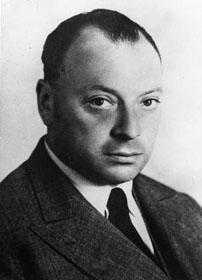| Wolfgang Pauli  AKA Wolfgang Ernst Friedrich Pauli AKA Wolfgang Ernst Friedrich Pauli
Born: 25-Apr-1900
Birthplace: Vienna, Austria
Died: 15-Dec-1958
Location of death: Zürich, Switzerland
Cause of death: unspecified
Remains: Buried, Zollikon Cemetery, Zürich, Switzerland
Gender: Male
Religion: Agnostic
Race or Ethnicity: White
Sexual orientation: Straight
Occupation: Physicist Nationality: Switzerland
Executive summary: Pauli Exclusion Principle Wolfgang Pauli wrote his first published academic paper when he was 18, and came to scientific fame at the age of 20, while still a student at University of Munich, when he wrote a lengthy article for the Encyclopedia of Mathematical Sciences explaining the theory of relativity with unprecedented clarity. After reading Pauli's article, Albert Einstein wrote, "One wonders what to admire most, the psychological understanding for the development of ideas, the sureness of mathematical deduction, the profound physical insight, the capacity for lucid, systematical presentation, the knowledge of the literature, the complete treatment of the subject matter, or the sureness of critical appraisal." He was a high school classmate and friend of Richard Kuhn, then studied under Arnold Sommerfeld, and later worked as an assistant to both Max Born and Niels Bohr.
In 1925 Pauli made his most famous discovery, the Pauli exclusion principle, addressing the anomalous Zeeman effect by surmising that two electrons in an atom can never share the same quantum state or configuration at the same time. In a 1926 paper he introduced his fourth quantum number, or a fourth degree of freedom, to explain characteristics of the hydrogen atom that had puzzled other physicists. His 1928 attempts to integrate the quantum principle with the interaction of radiation and matter set the stage for the development of quantum field theory. In 1930 he proposed the existence of neutral particles of low mass but with spin, the neutrino. Einstein nominated Pauli for the highest honor in science, the Nobel Prize, which he received in 1945.
He was Jewish by heredity, but was not told of this until his mid-teens. His father converted to Catholicism before marrying Pauli's mother, and he was raised in the Roman Catholic faith. His parents quit the church in 1911 and Pauli himself withdrew from Catholicism in 1929, though none of the Paulis publicly explained their reasons. His personal life was troubled — he drank heavily, his first marriage lasted less than a year before ending in divorce, and his mother killed herself in 1927. He sought help from psychologist Carl Jung, who instead arranged for Pauli to see one of Jung's assistants. Jung and Pauli, however, engaged in written correspondence, and Jung published a collection of Pauli's dreams in 1935. He sometimes told friends he wished he had been a comedian instead of a physicist. His middle name, Ernst, was a tribute to family friend and Pauli's godfather Ernst Mach. His sister, Hertha Pauli, was a journalist and actress of some renown. Father: Wolfgang Joseph Pauli (physician, b. 11-Sep-1869)
Mother: Berta Camilla Schütz (b. 29-Nov-1878, m. 2-May-1899, d. 15-Nov-1927 suicide)
Sister: Hertha Ernestina Pauli (journalist, b. 4-Sep-1906, d. 9-Feb-1973)
Wife: Käthe Margarethe Deppner (dancer, m. 23-Dec-1929, div. 29-Nov-1930)
Wife: Franca Bertram (m. 4-Apr-1934)
High School: Döblinger Gymnasium, Vienna, Austria (1918)
University: PhD, University of Munich (1921)
Scholar: University of Göttingen (assistant to )
Scholar: University of Copenhagen (assistant to )
Lecturer: University of Hamburg (1923-28)
Professor: Theoretical Physics, Swiss Federal Institute of Technology, Zürich (1928-40)
Professor: Visiting Professor, University of Michigan (1931)
Professor: Visiting Professor, Institute for Advanced Study, Princeton, NJ (1935)
Professor: Theoretical Physics, Princeton University (1940-45)
Professor: Visiting Professor, University of Michigan (1941)
Professor: Visiting Professor, Purdue University (1942)
Professor: Theoretical Physics, Swiss Federal Institute of Technology, Zürich (1945-58)
Lorentz Medal 1931
Nobel Prize for Physics 1945
Matteucci Medal 1956
Max Planck Medal 1958
American Physical Society
American Association for the Advancement of Science
Institute for Advanced Study Visiting Professor, 1935
Royal Society Foreign Member, 1953
Swiss Physical Society
Austrian Ancestry
Jewish Ancestry
Lunar Crater Pauli (44.5° S, 137.5° E, 84 km. diameter)
Risk Factors: Alcoholism, Depression, Smoking
Author of books:
Die Allgemeinen Prinzipien der Wellenmechanik (General Principles of Quantum Mechanics) (1946, non-fiction)
Writings on Physics and Philosophy (1994, collected papers; posthumous)
Requires Flash 7+ and Javascript.
Do you know something we don't?
Submit a correction or make a comment about this profile
Copyright ©2019 Soylent Communications
|